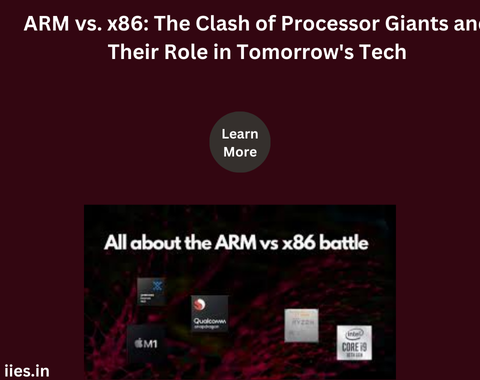
The debate between ARM and x86 has long shaped the landscape of computing, pitting two processor architectures against each other with different design philosophies and use cases. While both architectures are titans in the tech world, their roles and influence on the future of technology vary based on trends, innovation, and the rapidly evolving needs of industries.
ARM (Advanced RISC Machine) and x86 (originally developed by Intel) represent two different approaches to processor architecture. ARM is based on Reduced Instruction Set Computing (RISC), which uses a simplified set of instructions to perform tasks more efficiently. The architecture is lightweight, power-efficient, and designed for flexibility, making it ideal for mobile devices, embedded systems, and, increasingly, servers and desktops.
In contrast, x86 is based on Complex Instruction Set Computing (CISC), where more complex instructions can be executed in fewer cycles. This design allows x86 processors to handle intensive tasks, making them well-suited for desktops, servers, and high-performance computing. However, this complexity often results in higher power consumption and heat generation.
Over the last decade, ARM’s influence has surged, largely driven by the explosion of mobile computing. Companies like Apple, Qualcomm, and Nvidia have adopted ARM for smartphones, tablets, and other portable devices due to its superior power efficiency and lower heat production compared to x86. Apple’s transition to ARM-based processors in its Mac lineup, beginning with the M1 chip, marked a significant shift in the industry, signaling that ARM could compete with x86 even in high-performance environments.
The shift toward ARM also reflects broader industry trends. As cloud computing, Internet of Things (IoT) devices, and edge computing become more prominent, ARM’s low-power, scalable architecture provides the flexibility these technologies demand. Its presence in embedded systems, automotive technologies, and IoT has given ARM an edge in new, emerging markets where energy efficiency is critical.
Despite ARM’s rising prominence, x86 remains a force in high-performance computing, gaming, and enterprise environments. Intel and AMD, the two primary players in the x86 space, continue to innovate by offering powerful processors capable of handling the most demanding tasks, including rendering, simulations, artificial intelligence (AI), and server workloads.
x86’s strength lies in its legacy and ecosystem. With decades of development, the software ecosystem built around x86 is vast and robust. Many applications, particularly those requiring significant computational power, are optimized for x86. High-end gaming PCs, data centers, and workstations often favor x86 for this reason, providing unmatched performance for intensive workloads.
As the tech world shifts toward more diverse and power-efficient solutions, the performance gap between ARM and x86 is narrowing. ARM’s move into the server and desktop markets has been driven by significant performance improvements. For instance, Apple’s M-series processors, starting with the M1, demonstrated that ARM can deliver performance per watt that rivals—and even surpasses—x86 chips in certain use cases, particularly when balancing power consumption and heat generation.
On the other hand, x86 still dominates in scenarios that demand raw power, such as data centers, high-performance computing (HPC), and gaming. Intel’s Xeon and AMD’s EPYC processors are industry standards for server workloads, providing the computational muscle required by large-scale enterprises and cloud services. The energy-efficiency gap is closing, but for extreme performance tasks, x86 is still king.
The future of ARM and x86 will likely involve more crossover than competition. ARM is expected to continue its growth in mobile, IoT, and even desktop computing, while also making significant inroads in the server market. Major companies, including Amazon Web Services (AWS) with its Graviton processors, are already leveraging ARM for cloud-based workloads due to its power efficiency and scalability. In edge computing and IoT, ARM will likely remain the dominant architecture, given its minimal energy demands.
x86, on the other hand, will maintain a stronghold in areas where performance is critical. The gaming industry, for example, still leans heavily on x86 for the raw processing power required for high-end titles. Likewise, as artificial intelligence and machine learning continue to evolve, x86’s ability to handle intensive calculations will ensure it remains relevant in research, data science, and enterprise-level AI deployments.
One potential future development is the adoption of hybrid architectures that combine the strengths of ARM and x86. Some experts predict a future where both architectures coexist within the same systems, each handling tasks where it excels. For example, ARM cores could handle low-power background tasks, while x86 cores are employed for high-performance tasks. This combination could offer users the best of both worlds—power efficiency when needed and raw performance when demanded.
The ARM vs. x86 debate reflects more than just a technical rivalry—it highlights the shifting demands of the tech industry. ARM’s strength in power efficiency and flexibility is increasingly crucial as the world moves toward mobile, IoT, and cloud computing. x86, however, will continue to reign in high-performance applications and legacy systems.
Ultimately, both architectures will play a significant role in shaping the future of technology. ARM’s rise signals a new era of computing where power efficiency and scalability are key, while x86’s legacy of performance ensures its place in demanding tasks. As these architectures continue to evolve, the line between them may blur, but the clash of these processor giants will shape the tech world for years to come.
Indian Institute of Embedded Systems – IIES